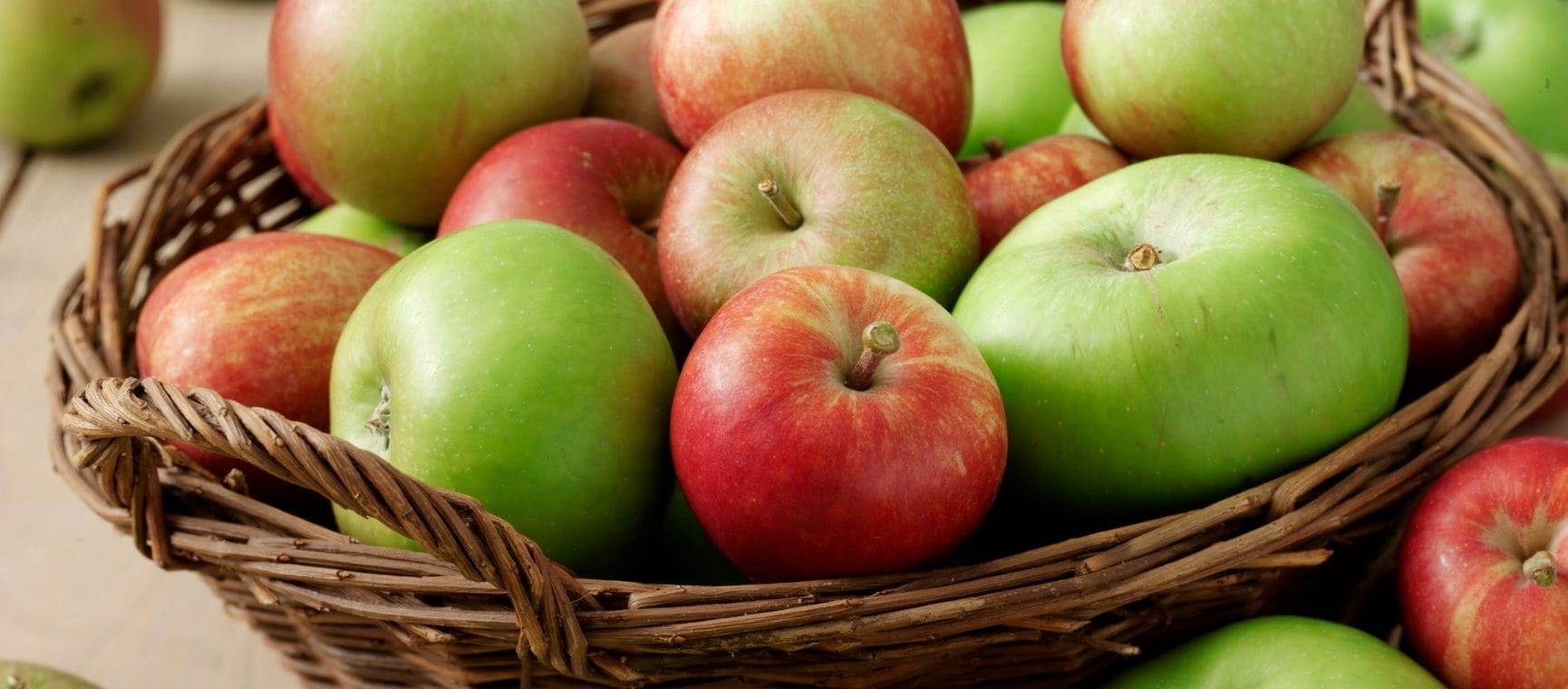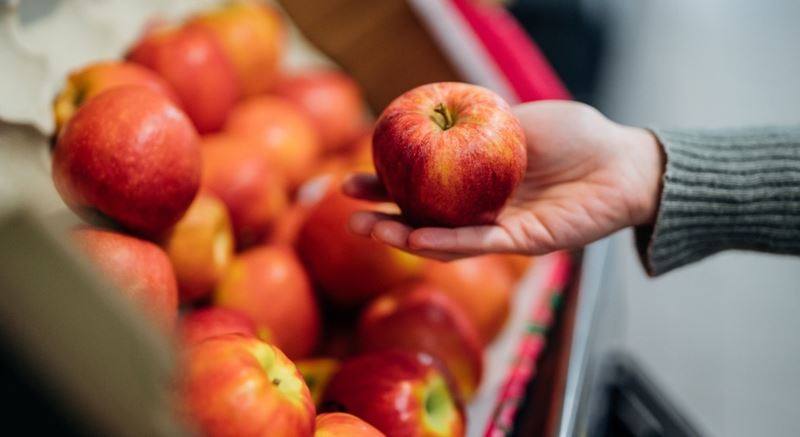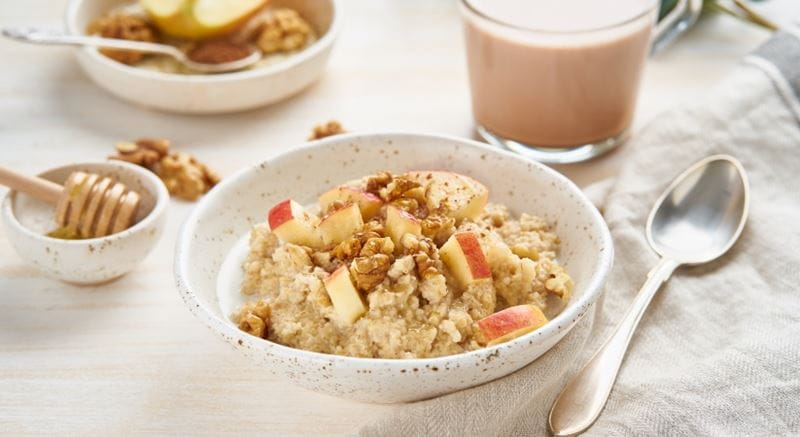Should you eat an apple a day? And which varieties are best?
From Granny Smiths to Pink Ladies, we peel away the myths to get to the core of an apple’s wellness credentials – including some surprising health benefits.

From Granny Smiths to Pink Ladies, we peel away the myths to get to the core of an apple’s wellness credentials – including some surprising health benefits.

Are red or green apples more nutritious? Should we always eat the peel? Is it best to serve apples hot or cold? And is apple juice just as healthy?
We have all the apple answers, plus the hidden health benefits you might not know about.
Whether your apple preference is a tangy Granny Smith or a sweet Red Delicious, each variety packs a slightly different nutritional punch (or crunch). From boosting our digestive system to lowering cholesterol, they’re a valuable addition to our diet as we age.
But did you know that all apples are natural beauty-boosters? And that they can help with urinary health and hormonal imbalance?
While they might not keep the doctor away, one study conducted over a 15-year period found that female participants aged over 70 who ate an apple a day were 35% more likely to live longer.
Eaten whole, you just can’t beat that satisfying first bite of an apple, but it also morphs into the ultimate comfort food when served warm in the colder months.
Affordable, versatile (who doesn't love a crumble?) and with a whopping 2,000 UK varieties – each with their own unique taste and texture – there’s a pomme for everyone.

Nutritional therapist and author Clemmie Pellew-Harvey heralds the all-round nutritional value of the humble apple, and says that a wealth of science backs the “apple-a-day” claim.
Apples contain bone-strengthening minerals, polyphenols and boron, which offers crucial support for calcium absorption and bone mineralisation.
Pellew-Harvey says: “Studies suggest that regular apple consumption is linked to higher bone density, which is crucial for preventing osteoporosis and fractures.”
A medium apple provides roughly 4g of fibre, supporting cardiovascular function and reducing heart disease risk by up to 15% in regular consumers.
“The soluble fibre (pectin) in apples helps lower LDL cholesterol, while polyphenols reduce inflammation and blood pressure,” explains Pellew-Harvey.
However, Maureen Talbot, as senior cardiac nurse at the British Heart Foundation, points out: “The ‘apple-a-day’ message has survived for over a century, but it shouldn’t replace vital heart medicines, such as statins, prescribed by your doctor.”
The quest for healthy, glowing skin shouldn’t stop at expensive serums and creams. We need to nourish our skin from within, and apples are rich in anti-ageing antioxidants and vitamin C.
“Together they combat free radical damage, supporting collagen production and skin elasticity,” adds Pellew-Harvey. “They’re typically 85% water, and the combination of hydration and these natural compounds make apples a genuine ‘beauty food’.”
Hollywood actress Reese Witherspoon credits a daily green smoothie – featuring a whole apple – for her youthful appearance. She said in a recent podcast: “I’ve been drinking it for 10 years – it’s changed my skin and my hair, and it makes your eyes white.”
Despite their natural sugars, apples have a low glycemic index (GI~36) thanks to their fibre content, which slows sugar absorption.
Pellew-Harvey says that this makes them ideal for blood sugar stability and type-2 diabetes prevention or management.
The pectin (fibre) in apples acts as a prebiotic, feeding beneficial gut bacteria and promoting regular bowel movements. Pellew-Harvey explains: “A healthy microbiome supports immunity, mood and nutrient absorption – all critical in later life.”
And in terms of satiety, apples are the perfect snack to keep you fuller for longer, with their high water and fibre content. At between just 50 and 80 calories per apple, they’re little bombs of easy-to-grab nutritional goodness that can satisfy that sweet craving without the waistline worries.
Pellew-Harvey explains that the humble apple can even offer targeted support for women’s health concerns:
When it comes to nutrition, not all apples are equal. So it’s a good idea to mix up your shopping list every so often and welcome some new apple friends into your fruit bowl.
We list here the most popular UK apple varieties, alongside their stand-out health benefits and key nutrients.
| Variety | Best for | Key nutrients |
|---|---|---|
|
Granny Smith
|
Maximum antioxidants and fibre
|
Highest polyphenol content
|
|
Red Delicious
|
Heart health
|
High in anthocyanins (red pigment); more antioxidants than Golden
|
|
Honeycrisp
|
Balanced nutrition and taste
|
Good fibre; moderate polyphenols; popular for texture
|
|
Golden Delicious
|
Gentler digestion
|
Slightly lower fibre; sweeter; easier on sensitive stomachs
|
|
Pink Lady
|
Longevity and storage
|
High polyphenol content; stores well without nutrient loss
|
|
Braeburn
|
Sustained energy
|
Good fibre-to-sugar ratio; keeps you fuller longer
|
Pellew-Harvey summarises: “The overall winners here are Granny Smith and Red Delicious, because they edge ahead for sheer antioxidant density.
“Variety is key – don’t forget to rotate them to maximise nutrient diversity.”
The simple answer is a resounding YES – 50% of an apple’s fibre lives in or just under the skin, and up to 90% of polyphenols are concentrated in the peel.
Red apple peel contains anthocyanins, which are powerful antioxidants linked to heart and brain health. The deeper-shaded red-skinned apples have a higher anthocyanin concentration.
Meanwhile, green and yellow peels contain chlorophyll and lutein content, for anti-inflammatory and eye health benefits.
“Red-skinned varieties offer a slight edge, but any apple with the skin intact beats a peeled one,” says Pellew-Harvey. “Wash thoroughly (organic or not) and enjoy the whole fruit.”
While it’s advised to step away from the apple-peeler, the same needn’t be said for the corer.
It’s perfectly fine to eat the core, though most of us will pass on its tough texture and pesky seeds.
Pellew-Harvey adds: “Apple seeds contain amygdalin, which breaks down into cyanide in small amounts, but you’d need to consume an unrealistic number to cause harm – roughly over 150 apple cores, which is unlikely! And no need to stress if you occasionally swallow a few seeds.”

While raw apples win on polyphenol content, as heat degrades some antioxidants, cooking offers some surprising benefits too:
| Method | Pros | Cons |
|---|---|---|
|
Raw
|
Maximum polyphenols and vitamin C; satisfying crunch
|
Harder to digest for some; higher natural sugars perceived as more concentrated
|
|
Baked/stewed
|
Easier digestion; pectin becomes more bioavailable; comforting
|
Some polyphenols lost; ideal for winter warmth
|
|
Cooked with cinnamon
|
Anti-inflammatory boost; blood sugar support
|
Minimal nutrient loss; perfect for digestive support
|
Pellew-Harvey summarises: “Eating raw apples most days is a brilliant way to up our nutrient intake, but don’t forget about cooked apples. Baked and stewed, they’re particularly comforting in winter and beneficial for blood sugar and gut health.”
While it contains some of the beneficial compounds found in its whole form, apple juice is missing the crucial fibre that packs the fruit’s most powerful nutritional punch, and therefore 90% of its digestive and prebiotic effects.
There’s also a sugar pitfall at play, says Pellew-Harvey: “An 8oz glass of apple juice contains roughly 24g of sugar – around 14g more than a whole apple – without the fibre to slow absorption. This spikes blood sugar and is problematic for diabetes management.”
The processing and storage of apple juice also means a loss of those bone- and heart-healthy polyphenols. However, for those with severe digestive complaints who can’t tolerate whole apples, Pellew-Harvey recommends a glass of diluted apple juice with 50% water.

Core a Granny Smith apple, stuff with chopped almonds, dates and a pinch of cinnamon.
Bake at 180°C for 20 minutes. Serve with Greek yogurt, plus a sprinkle of nuts and seeds for extra protein, omega 3s and probiotics.
Dice a raw apple into warm oats with walnuts, ground flaxseed and a drizzle of honey.
The raw apple adds crunch and maximum polyphenols; walnuts provide omega-3s.
Blend one apple (a Granny Smith), a handful of dark leafy greens, Greek yogurt and water.
Add a squeeze of lemon to enhance iron absorption. No added sugar needed.
Grate raw apples and beetroot, and toss with shredded cabbage. Dress with tahini, lemon juice and olive oil.
The raw apple provides enzymes and polyphenols; tahini adds calcium and minerals.
Layer sliced apples with cinnamon, nutmeg and a splash of apple juice or water. Cook on low for 4 hours.
Serve warm with natural yogurt or porridge, or alongside roasted chicken. The long, gentle cooking makes this incredibly digestible and perfect for winter comfort.
Simmer diced apples with fresh ginger, turmeric, a pinch of black pepper and a touch of honey for 10 minutes. Serve warm as a digestive aid or alongside breakfast.
Perfect for inflammation and joint health, and ideal for chilly mornings.
Layer sliced apples in a small baking dish with a squeeze of lemon juice. Top with a crumble mix of oats, ground almonds, coconut oil and a touch of honey.
Bake at 190°C for 25 minutes until golden. Serve warm with custard or natural yogurt.
Stew sliced apples with frozen blackberries and a cinnamon stick until soft (about 8 minutes). Cool slightly, then fold through whipped Greek yogurt.
Serve in glasses for an elegant, warming dessert. The blackberries add extra anthocyanins and a beautiful colour.
Simmer sliced apples, cinnamon sticks, star anise, cloves and a slice of fresh ginger in hot water for 10 minutes. Strain and serve warm.
A soothing, naturally sweet drink that aids digestion and provides warmth without caffeine. Perfect for afternoon comfort.
Core large apples and stuff with a mixture of rolled oats, chopped walnuts, dried cranberries, cinnamon and a drizzle of maple syrup. Bake at 180°C for 25-30 minutes, until tender.
Serve warm as a breakfast or light dessert. This is pure autumn comfort – hearty, warming and genuinely good for you.
(Hero image credit: Getty Images)
Recipes by Clemmie Pellew-Harvey. For more nutritional advice and inspiration, visit her Wellness With Clemmie social media pages.
Emma Lazenby is entering her third decade in journalism, after starting her reporting career on the Yorkshire Evening Post as a teenager.
She’s loved every minute, with contributions to the Sun, Daily Telegraph and women’s magazines, between stints as a Lifestyle Editor for the Press Association and TV Producer for GMTV and Steph’s Packed Lunch.
Emma has covered mental and physical health, charity campaigns, fashion and beauty, travel, food and parenting with celebrity and inspirational real-life interviews featuring heavily.

Saga offers escorted tours throughout Europe and as far afield as Canada, Australia and even Uzbekistan, plus hotel stays in popular European hotspots including Spain, Portugal and Greece.
Find your perfect holiday today.

Health insurance for people over 50 that provides a quicker route to diagnosis and planned medical treatment in a private facility.
Underwritten by Bupa Insurance Limited.

Are you retiring at the wrong age? The best age to retire for your body, brain, happiness and pocket.


Everything you need to know about the lung infection, and how you could be ill with “walking” pneumonia without realising it.

Strong calves for a strong mind: how they support our circulation and brain health, with easy moves to strengthen yours at home.


Our GP Dr Mark Porter explains what can cause itchy skin, which is a common problem as we get older.

Worried you’ve morphed into Victor Meldrew? Find out how to battle that bad mood, and what to do if you’re stuck with a grouchy loved one.

The benefits of heat and cold therapy, and how Nordic bathing won over our nervous writer.

Here’s how to spot the symptoms of heat disease and reduce your danger.


The NHS winter vaccination campaign kicks off next week. Here’s the lowdown on what you need to book.

Pilates for back pain – what to do if you are suffering, and five gentle exercises that could help.

Dizziness or vertigo: a sensation of spinning, can stop us doing everyday things for fear of falling. Try these tips to stop feeling dizzy


You don’t have to put up with bladder leaks. We try out the latest pelvic floor gadgets for men and women.

Cataracts are a normal part of ageing. Learn how to spot the signs – and when it’s time to consider surgery.